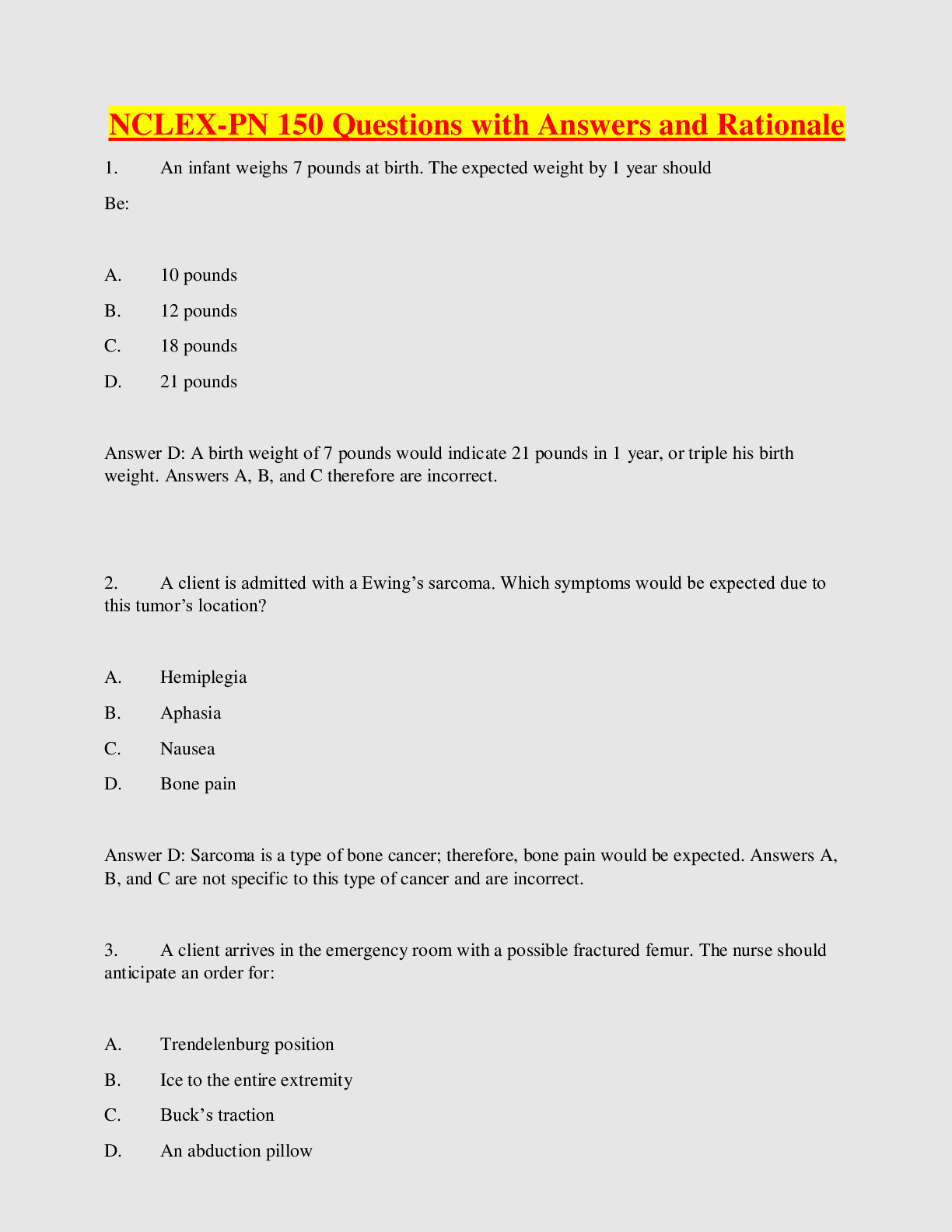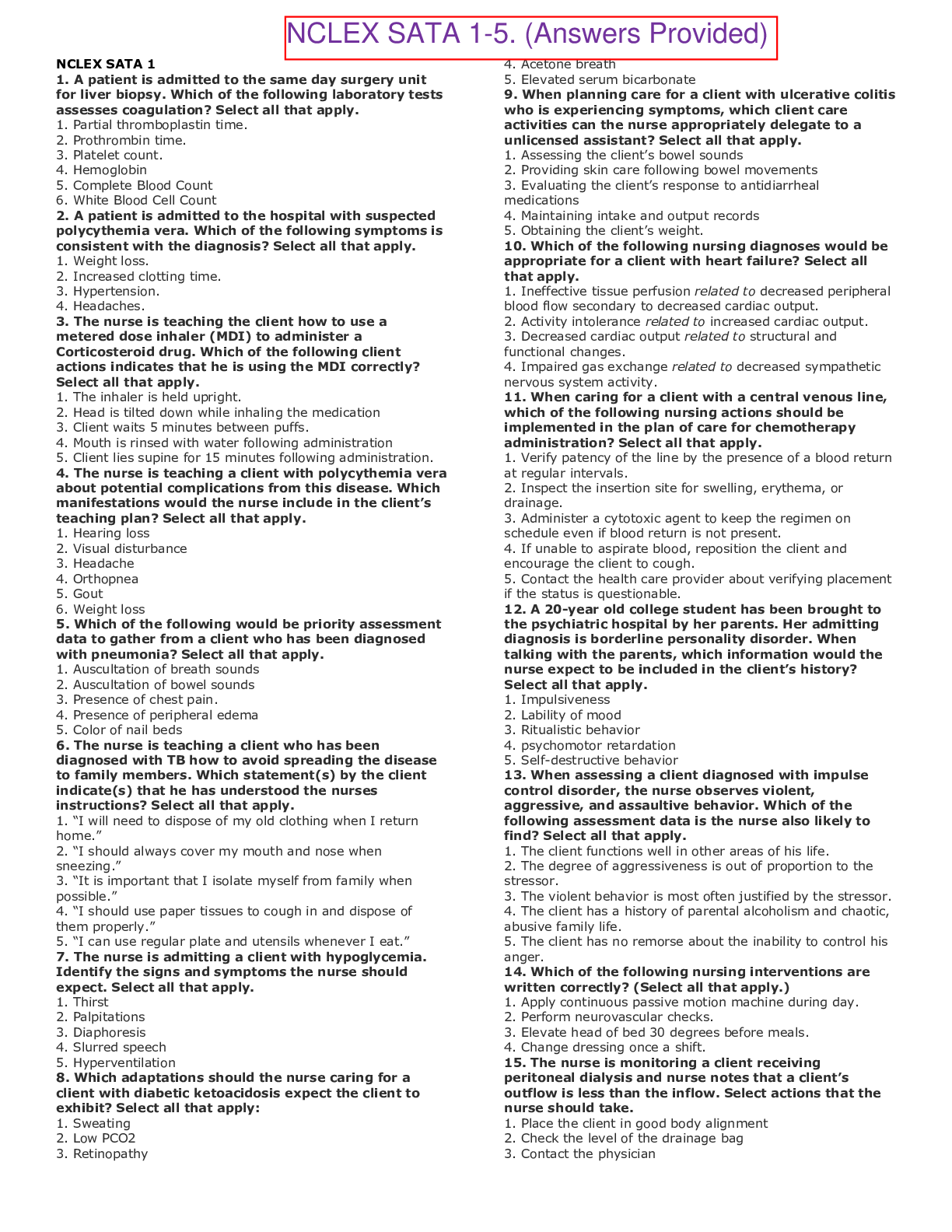*NURSING > NCLEX-PN > PN CAPSTONE NCLEX QUESTIONS_4 ( latest 2020) – Rasmussen College | PN CAPSTONE NCLEX QUESTIONS_4 ( (All)
PN CAPSTONE NCLEX QUESTIONS_4 ( latest 2020) – Rasmussen College | PN CAPSTONE NCLEX QUESTIONS_4 ( latest 2020)
Document Content and Description Below
PN CAPSTONE NCLEX QUESTIONS_4 ( latest 2020) – Rasmussen College 1. Which intervention is appropriate for the nurse caring for a male client in severe pain receiving a continuous I.V. infusion ... of morphine? a. Assisting with a naloxone challenge test before therapy begins b. Discontinuing the drug immediately if signs of dependence appear c. Changing the administration route to P.O. if the client can tolerate fluids d. Obtaining baseline vital signs before administrating the first dose. 2. When caring for a client who has a colostomy created as part of a regimen to treat colon cancer, which activities would help to support the client in accepting changes in appearance or function? Select all that apply. a. Explain to the client that the colostomy is only temporary b. Encourage the client to participate in changing the ostomy c. Obtain a psychiatric consultation d. Offer to have a person who is coping with a colostomy visit e. Encourage the client and family members to express their feelings and concerns. 3. The nurse has received in report that the client receiving chemotherapy has severe neutropenia. Which of the following does the nurse plan to implement? Select all that apply. a. Assess for fever b. Observe for bleeding c. Administer Neulasta d. Do not permit fresh flowers or plants in the room e. Do not allow his 16 year old son to visit f. Teach the client to omit raw fruits and vegetables from his diet. 4. Which of the following findings would alarm the nurse when caring for a client receiving chemotherapy who has a platelet count of 17,000/mm3 a. Increasing shortness of breath b. Diminished bilateral breath sounds c. Change in mental status d. Weight gain of 4 pounds in 1 day 5. A 35 years old client with ovarian cancer is prescribed hydroxyurea (Hydrea), an anti-metabolite drug. Anti-metabolites are a diverse group of antineoplastic agents that interfere with various metabolic actions of the cells. The mechanism of action of anti-metabolites interferes with: a. Cell division or mitosis during the M phase of the cell cycle b. Normal cellular processes during the S phase of the cell cycle c. The chemical structure of deoxyribonucleic acid (DNA) and chemical binding between DNA molecules (Cell cycle-nonspecific). d. One or more stage of ribonucleic acid (RNA) synthesis, DNA synthesis, or both (cell cycle-nonspecific) 6. The ABCD method offers one way to assess skin lesions for possible skin cancer. What does the A stand for? a. Actinic b. Asymmetry c. Arcus d. Assessment 7. When caring for a male client diagnosed with a brain tumor of the parental lobe, the nurse expects to assess: a. Short-term memory impairment b. Tactile agnosia c. Seizures d. Contralateral homonymous hemianopia 8. A female client is undergoing tests for multiple myeloma. Diagnostic study findings in multiple myeloma include: a. A decreased serum creatinine level b. Hypocalcemia c. Bence Jones protein in the urine d. A low serum protein level 9. A 35 year old client has been receiving chemotherapy to treat cancer. Which assessment finding suggests that the client has developed stomatitis (inflammation of the mouth)? a. White, cottage cheese-like patches on the tongue b. Yellow tooth discoloration c. Red, open sores on the oral mucosa d. Rust-colored sputum 10. During chemotherapy, an oncology client has a nursing diagnosis of impaired oral mucous membrane related to decreased nutrition and immunosuppression secondary to the cytotoxic effects of chemotherapy. Which nursing intervention is most likely to decrease the pain of stomatitis? a. Recommending that the client discontinue chemotherapy b. Proving a solution of hydrogen peroxide and water for use as a mouth rinse c. Monitoring the client’s platelet and leukocyte counts d. Checking regularly for signs and symptoms of stomatitis 11. What should a male client over age 52 do to help ensure early identification of prostate cancer? a. Have a digital rectal examination and prostate-specific antigen (PSA) test done yearly. b. Have a transrectal ultrasound every 5 years c. Perform monthly testicular self-examinations, especially after age 50 d. Have a complete blood count (CBC) and blood urea nitrogen (BUN) and creatinine levels checked yearly 12. A male client complains of sporadic epigastric pain, yellow skin, nausea, vomiting, weight loss and fatigue. Suspecting gallbladder disease, the physician orders a diagnostic workup, which reveals gallbladder cancer. Which nursing diagnosis may be appropriate for this client? a. Anticipatory grieving b. Impaired swallowing c. Disturbed body image d. Chronic low self-esteem 13. A male client is in isolation after receiving an internal radioactive implant to treat cancer. Two hours later, the nurse discovers the implant in the bed linens. What should the nurse do first? a. Stand as far away from the implant as possible and call for help b. Pick up the implant with long-handled forceps and place it in a lead-linen container c. Leave the room and notify the radiation therapy department immediately d. Put the implant back in place, using forceps and a shield for self-protection, and call for help 14. Jeovina with advance breast cancer is prescribed tamoxifen (Nolvadex). When teaching the client about this drug, the nurse should emphasize the importance of reporting which adverse reaction immediately? a. Vision changes b. Hearing loss c. Headache d. Anorexia 15. A female client with cancer is being evaluated for possible metastasis. Which of the following is one of the most common metastasis sites for cancer cells? a. Liver b. Colon c. Reproductive tract d. White blood cells (WBCs) 16. A 34-year old female client is requesting information about mammograms and breast cancer. She isn’t considered at high risk for breast cancer. What should the nurse tell this client? a. She should have had a baseline mammogram before age 30 b. She should eat a low-fat diet to further decrease her risk of breast cancer c. She should perform breast self-examination during the first 5 days of each menstrual cycle. d. When she begins having yearly mammograms, breast self-examination will no longer be necessary. 17. Nurse Brian is developing a plan of care for marrow suppression, the major dose-limiting adverse reaction to floxuridine (FUDR). How long after drug administration does bone marrow suppression become noticeable? a. 24 hours b. 2 to 4 days c. 7 to 14 days d. 21 to 28 days 18. You are caring for an infant with a diagnosis of sepsis. Which is the priority assessment for this infant? a. Skin integrity b. Temperature c. Jaundice d. Respiratory function 19. You are changing the tape on a tracheostomy tube when the patient coughs, and the tube becomes dislodged. The initial action of the nurse should be: a. Cover the site with a sterile dressing b. Notify the physician c. Grasp the retention sutures and spread the opening d. Notify the respiratory therapist 20. You are caring for a patient who is being admitted to the psychiatric unit. Which of the following would present the most concern to the nurse? a. Presence of bruises on the patient’s body b. Reports by the patient that they can’t eat or sleep c. Reports by the patient of suicidal thoughts d. Significant other’s disapproval of treatment 21. You are preparing a teaching session on tuberculosis. What is one of the first symptoms that the group might notice in someone who has tuberculosis? a. Bloody, productive cough b. Cough with mucoid sputum c. Chest pain d. Dyspnea 22. You have drawn an arterial blood gas on your patient. In reviewing the results you note the flowing: pH 7.45, PCO2 of 30, mm Hg, and bicarbonate of 22mEq/L. What do you interpret these results to mean? a. Metabolic acidosis, compensated b. Metabolic alkalosis, compensated c. Respiratory acidosis, compensated d. Respiratory alkalosis, compensated 23. You have delegated care of a patient in restraints to a nursing assistant. How often should the nursing assistant assess skin integrity for this patient? a. Every 30 minutes b. Every 2 hours c. Every 3 hours d. Every 4 hours 24. Which of the following assessments by the nurse would indicate a possible manifestation of dementia? a. Presence of personal hygienic care b. Improvement in sleeping c. Absence of sundown syndrome d. Confabulation 25. You are caring for a patient who has been sexual assaulted. The patient has become quiet and calm. What defense mechanism does this indicate to the nurse? a. Denial b. Projection c. Rationalization d. Intellectualization 26. What nursing action would the nurse take when caring for a patient with enucleation with bright red drainage? a. Notify the physician b. Continue to monitor the drainage c. Document the finding d. Mark the drainage on the dressing 27. Your patient has been stung by a bee. What signs and symptoms would you see if the patient has an allergic reaction to the sting? a. Normal respiratory rate b. Prolonged expiratory phase c. Wheezing on inspiration d. Decreased respiratory rate 28. You are caring for a patient who demands to be released from the hospital immediately. The patient was admitted voluntary for an anxiety disorder. What actions should the nurse take next? a. Tell the patient that discharge is not possible at this time b. Call the patient’s family c. Notify the physician d. Persuade the patient to stay 29. The nurse is preparing for a female client for magnetic resonance imaging (MRI) to confirm or rule out a spinal cord lesion. During the MRI scan, which of the following would pose threat to the client? a. The client lies still b. The client asks questions c. The client hears thumping sounds d. The client wears a watch and wedding band 30. A client state that she is afraid of receiving vitamin B12 injections because of the potential toxic reactions. What is the nurse’s best response to relieve these fears? a. “Vitamin B12 will cause ringing in the eats before a toxic level is reached.” b. “Vitamin B12 may cause a very mild skin rash initially.” c. “Vitamin B12 may cause mild nausea but nothing toxic.” d. “Vitamin B12 is generally free of toxicity because it is water soluble.” 31. A client with microcytic anemia is having trouble selecting food items from the hospital menu. Which food is best for the nurse to suggest for satisfying the nutritional needs and personal preferences? a. Egg yolks b. Brown rice c. Vegetables d. Tea 32. A client with macrocytic anemia has a burn on her foot and states that she had been watching television while lying on a heating pad. What is the nurse’s first response? a. Assess for potential abuse b. Check for diminished sensations c. Document the findings d. Clean and dress the area 33. Which of the following nursing assessments is a late symptom of polycythemia vera? a. Headache b. Dizziness c. Pruritis d. Shortness of breath 34. The nurse is teaching a client with polycythemia Vera about potential complications from this disease. Which manifestations would the nurse include in the client’s teaching plan? Select all that apply. a. Hearing loss b. Visual disturbance c. Headache d. Orthopnea e. Gout f. Weight loss 35. When a client is diagnosed with aplastic anemia, the nurse monitors for changes in which of the following physiological functions? a. Bleeding tenderness b. Intake and output c. Peripheral sensation d. Bowel function 36. Which of the following blood components is decrease in anemia? a. Erythrocytes b. Granulocytes c. Leukocytes d. Platelets 37. A client with anemia may be tired due to a tissue deficiency of which of the following substances? a. Carbon dioxide b. Factor VIII c. Oxygen d. T-cell antibodies 38. Which of the following cells is the precursor to the red blood cells (RBC)? a. B cell b. Macrophage c. Stem cell d. T cell 39. Which of the following symptoms is expected with hemoglobin of 10 g/dl? a. None b. Pallor c. Palpations d. Shortness of breath 40. Which of the following diagnostic findings are most likely for a client with aplastic anemia? a. Decreased production of T-helper cells b. Decreased levels of white blood cells, red blood cells, and platelets c. Increased levels of WBCs, RBCs, and platelets d. Reed-Sternberg cells and lymph node enlargement 41. A client with iron deficiency anemia is scheduled for discharge. Which instruction about prescribed ferrous gluconate therapy should the nurse include in the teaching plan? a. “Take the medication with an antacid.” b. “Take the medication with a glass of milk.” c. “Take the medication with cereal.” d. “Take the medication on an empty stomach.” 42. Which of the following disorders results from a deficiency of factor VIII? a. Sickle cell disease b. Christmas disease c. Hemophilia A d. Hemophilia B 43. The nurse explains to the parents of a 1-year-old child admitted to the hospital in a sickle cell crisis that the local tissue damage the child has on admission is caused by which of the following? a. Autoimmune reaction complicated by hypoxia b. Lack of oxygen in the red blood cells c. Obstruction to circulation d. Elevated serum bilirubin concentration 44. The mother asks the nurse why her child’s hemoglobin was normal at birth but now the child has S hemoglobin. Which of the following responses by the nurse is most appropriate? a. “The placenta bars passage of the hemoglobin S from the mother to the fetus.” b. “The red bone marrow does not begin to produce hemoglobin S until several months after birth.” c. “Antibodies transmitted from you to the fetus provide the newborn with temporary immunity.” d. “The newborn has a high concentrate of fetal hemoglobin in the blood for some time after birth.” 45. The nurse is giving discharge instructions to a patient with diabetes mellitus regarding glycated hemoglobin (HbA1c). the nurse knows that the patient understands the teachings if he states: a. HbA1c level is done to monitor long term control of my blood sugar level. b. HbA1c level is repeated every 12 months c. I will monitor my HbA1c every morning before eating my breakfast d. My capillary blood will be used to check my HbA1c level. 46. The nurse is reviewing the lab results of a patient taking warfarin for A-fib. Which of the following INR values would the nurse consider therapeutic for this patient? a. 0.8 b. 1.8 c. 2.4 d. 3.1 47. The nurse is caring for a patient with severe liver disease. The patient becomes confused and combative. To assess for the presence of hepatic encephalopathy, the nurse would expect the physician to order a serum level of: a. Ammonia b. Lactate c. Urea d. Uric acid 48. The nurse is caring for a patient on bed rest. The patient receives low dose heparin daily for the prevention of DVTs. The nurse notes that the patient’s aPTT level is within normal range. Which of the following aPTT levels is normal? a. 15 sec b. 35 sec c. 55 sec d. 65 sec 49. The nurse is reviewing the lab results of a jaundice patient suspected of having liver disease. The nurse would expect to note: (select all that apply) a. A decrease in albumin b. A decrease in bilirubin c. A rise in albumin d. A rise in aspartate transaminase e. A rise in bilirubin 50. A patient is admitted to the psychiatric unit after a failed suicide attempt. The nurse plans to write a suicide prevention contract. To promote compliance and build a trusting relationship with the patient, with contract should: a. Be written by the patient b. Be written by the physician c. Be written by the social worker d. Be written jointly by the nurse and the patient 51. A patient receiving multiple electroconvulsive treatment states to the nurse: “I can’t remember where I put anything. I am always confused and lose everything.” Which of the following responses by the nurse is most appropriate? a. I understand that your memory loss and confusion are upsetting you. Can you tell me more? b. This was an expected side effects c. You still really need this treatment d. Your memory will get better. 52. An elderly man is admitted to the hospital with pressure ulcers, poor hygiene, and malnutrition. The man lives with his daughter and her husband. The nurse suspects that he man is victim of: a. Emotional abuse b. Physical abuse c. Psychological abuse d. Sexual abuse 53. Which of the following would the nurse identify as the priority nursing diagnosis during a toddler’s vaso-occlusive sickle cell crisis?” a. Ineffective coping related to the presence of a life-threatening disease. b. Decreased cardiac output related to abnormal hemoglobin formation c. Pain related to tissue anoxia d. Excess fluid volume related to infection 54. The nurse is caring for a patient suspected of having systemic scleroderma. The nurse explains to the patient that systemic scleroderma (select all that apply) a. Causes weakness in the majority of patients b. Is an autoimmune disease that affects connective tissue c. Is characterized by inflammation fibrosis, and sclerosis d. Is caused by systemic lupus erythematosus e. Is triggered by an adenovirus 55. The nurse is caring for a patient with thrombocytopenia who has developed epistaxis. In order to stop the bleeding, the patient should: a. Blow his nose to remove the blood b. Lean forward at a 90 degree angle, bending at the waist c. Lie down with the neck extended d. Sit upright and lean forward 56. A 25 year old male is admitted to the hospital with the diagnosis of a sickle cell crisis. What consultation is a priority for this patient? a. Nutritionist b. Occupational therapist c. Pain specialist d. Physical therapist 57. Which type of blood cells release histamine during an anaphylactic reaction? a. Basophils b. Eosinophils c. Lymphocytes d. Neutrophils 58. The nurse administers vitamin B12 to a patient with pernicious anemia. This patient has the inability to absorb vitamin B12 because of a deficiency in: a. Extrinsic factor b. Folic acid c. Gastrin d. Intrinsic factor 59. The nurse is assessing a female patient of child bearing age for symptoms of iron-deficiency anemia, including: (select all that apply) a. Dyspnea b. Nausea c. Pallor d. Rash and pruritis e. Tachycardia f. Wt loss and night sweats 60. The nurse is caring for a patient with AIDS. To evaluate for early signs of Kaposi’s sarcoma, the nurse assesses the patient for lesions that are: a. Bilateral, flat, pruritic and brown b. Bilateral, popular, non-pruritic, and pink, brown or violet c. Unilateral, flat, non-pruritic and pink, brown or violet d. Unilateral, popular, non-pruritic, and pink, brown or violet 61. A patient is admitted to the hospital with signs and symptoms of systemic lupus erythematosus (SLE). Which test would confirm the diagnosis? a. Antinuclear antibody b. CBC c. Erythrocyte sedimentation rate d. Hepatobiliary scan 62. A patient walks into the ER after being bitten by a deer tick. The patient is nervous about Lyme disease. The nurse informs the patient that: (select all that apply) a. Blood tests are not reliable until 6 to 8 weeks after exposure b. Blood tests should be done immediately c. Lyme disease should be treated with antiviral immediately d. One should monitor for a bulls-eye rash e. You cannot get Lyme disease from deer ticks 63. The nurse is assigned to a patient at a risk for the development of disseminated intravascular coagulation (DIC). Which for the following lab values should the nurse monitor? a. Electrolytes and CBC b. Platelet count, WBC, and electrolytes c. PT, fibrinogen and electrolytes d. PT, PTT, and Platelet count 64. The nurse is assessing a patient with SLE, which of the following would the nurse expect to note? (select all that apply) a. Alopecia b. Butterfly rash on the face c. Excessive hair growth d. Hyperthyroidism e. Muscle pain and weakness f. Recurrent deep vein thrombosis 65. The nurse is reviewing the results of genetic testing of a patient with sickle cell disease, noting that HbS indicates sickle cell disease, HBAS indicates sickle cell trait and HbA indicates normal hemoglobin. The patient and her husband are at the lowest risk of having a child with sickle cell disease: a. The husband is HbA and wife is HbS b. The husband is HbAS and the wife is HbAS c. The husband is HbS and the wife is HbAS d. The husband is HbS and the wife is HbS 66. The nurse delegates an unlicensed assistive person (UAP) to assist a client with a clean urinary catheterization procedure. The client was formerly able to perform the procedure but because of arthritis, he is no longer able to do so. Although the UAP has done this procedure before, which direction must the nurse emphasize to the UAP? a. Let the client do most of the procedure and report the expected output. b. Report immediately any unusual observations, such as bleeding. c. Complete in proper order the steps of the procedure. d. Perform health teaching while performing the procedure. 67. Which action would the nurse take to maintain medical asepsis when caring for a client with diabetes mellitus on the medical nursing unit who requires irrigation of a leg ulcer and insulin injections? Select all that apply. a. Wash hands before and after client care. b. Wear personal protective equipment during the dressing change. c. Recap a needle after administrating insulin. d. Change the dressing for a diabetic ulcer using sterile gloves. e. Wipe the rubber stopped on the insulin vial before withdrawing dose. 68. Laboratory test results indicate a client is in the nadir period that follows administration of a chemotherapy drug. Which drug should the nurse avoid during administrating to this client at this time? a. Acetaminophen (Tylenol) b. Ibuprofen (Motrin) c. Diphenhydramine (Benadryl) d. Guaifenesin (Robitussin) 69. The mental health nurse working with children anticipates that unrealistic expectations or a sense of failure to meet standards would cause a 10 year old child to develop a sense of the following? a. Shame b. Guilt c. Inferiority d. Role confusion 70. The nurse is assigned to a client diagnosed with head and neck cancer who is receiving enteral feedings via gastrostomy tube. When the nurse is called away to care for another client, which task for this client could most appropriately be delegated to the unlicensed assistive person (UAP)? A. Determining the amount of residual for the tube feeing. B. Giving mouth care and assessing the oral cavity. C. Exploring how the client is currently coping with the diagnosis. D. Administering a bath and changing bed linens. [Show More]
Last updated: 1 year ago
Preview 1 out of 16 pages
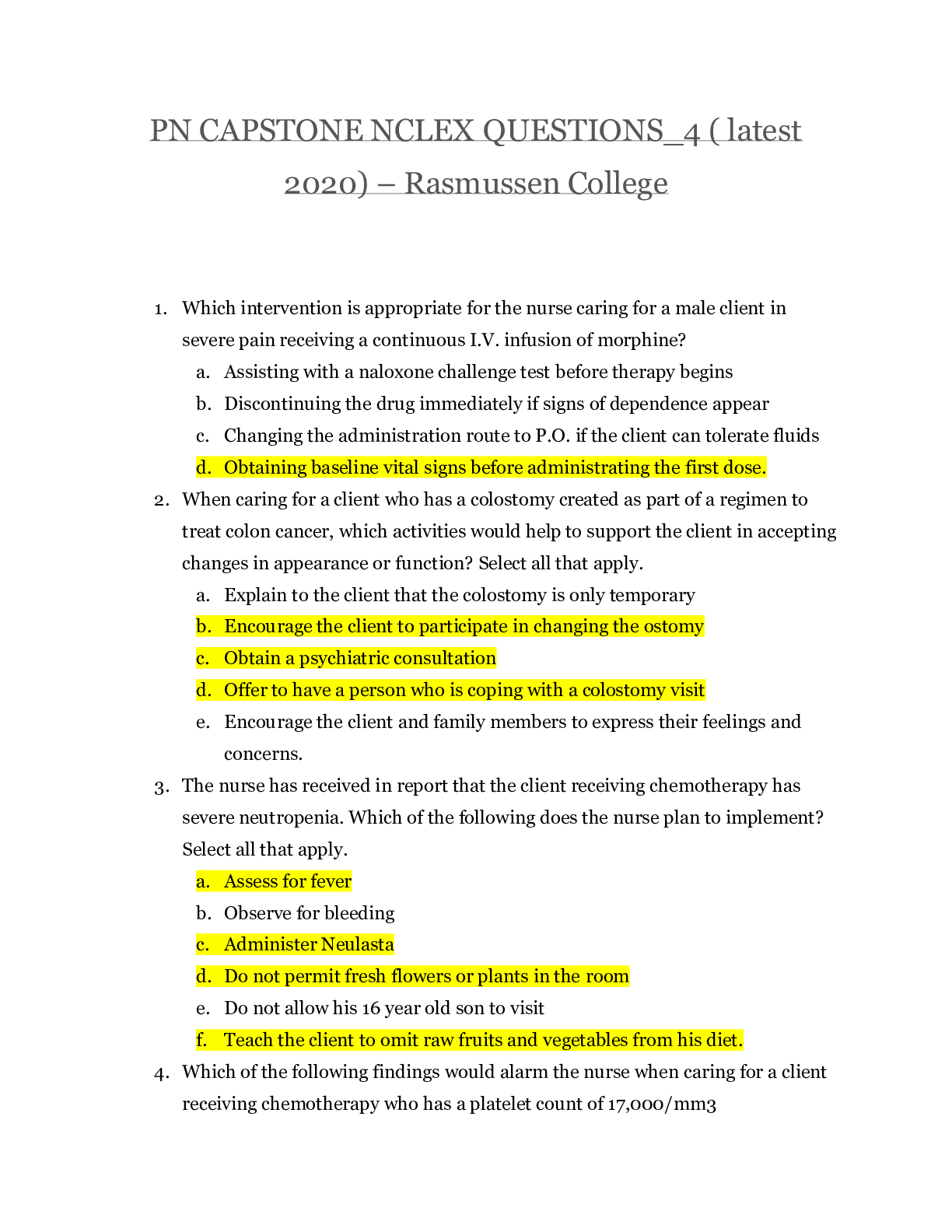
Reviews( 0 )
Document information
Connected school, study & course
About the document
Uploaded On
Jul 30, 2020
Number of pages
16
Written in
Additional information
This document has been written for:
Uploaded
Jul 30, 2020
Downloads
0
Views
83

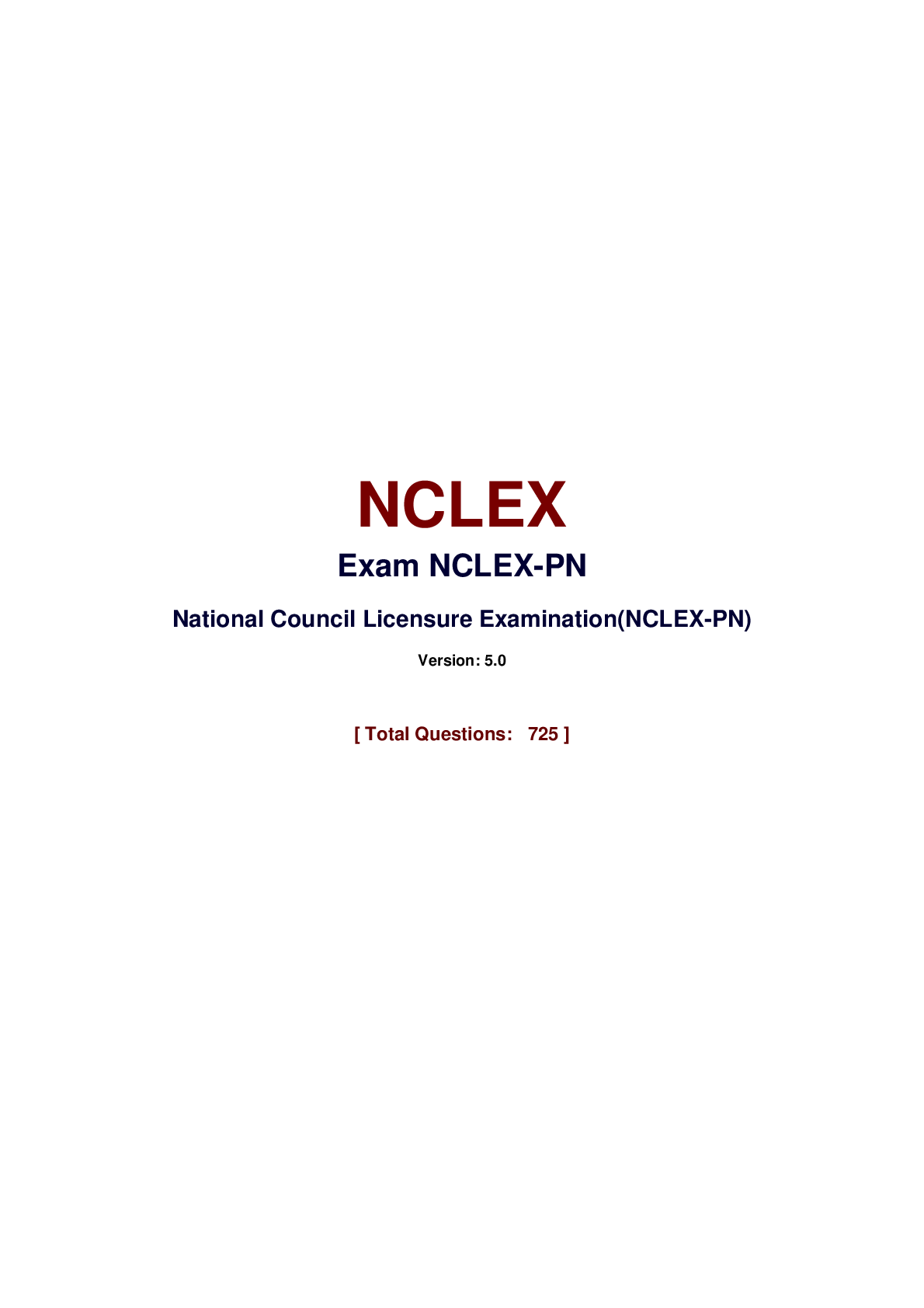

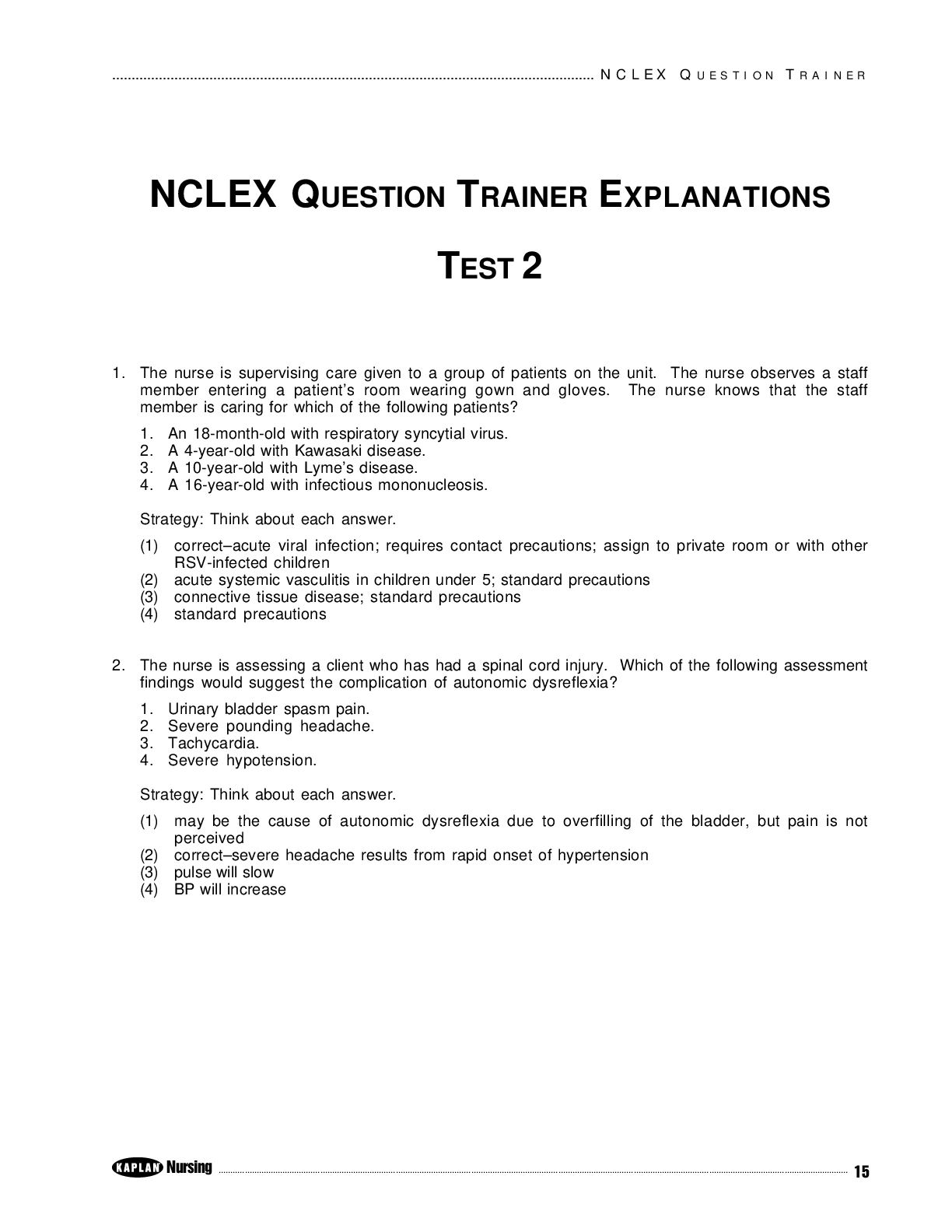
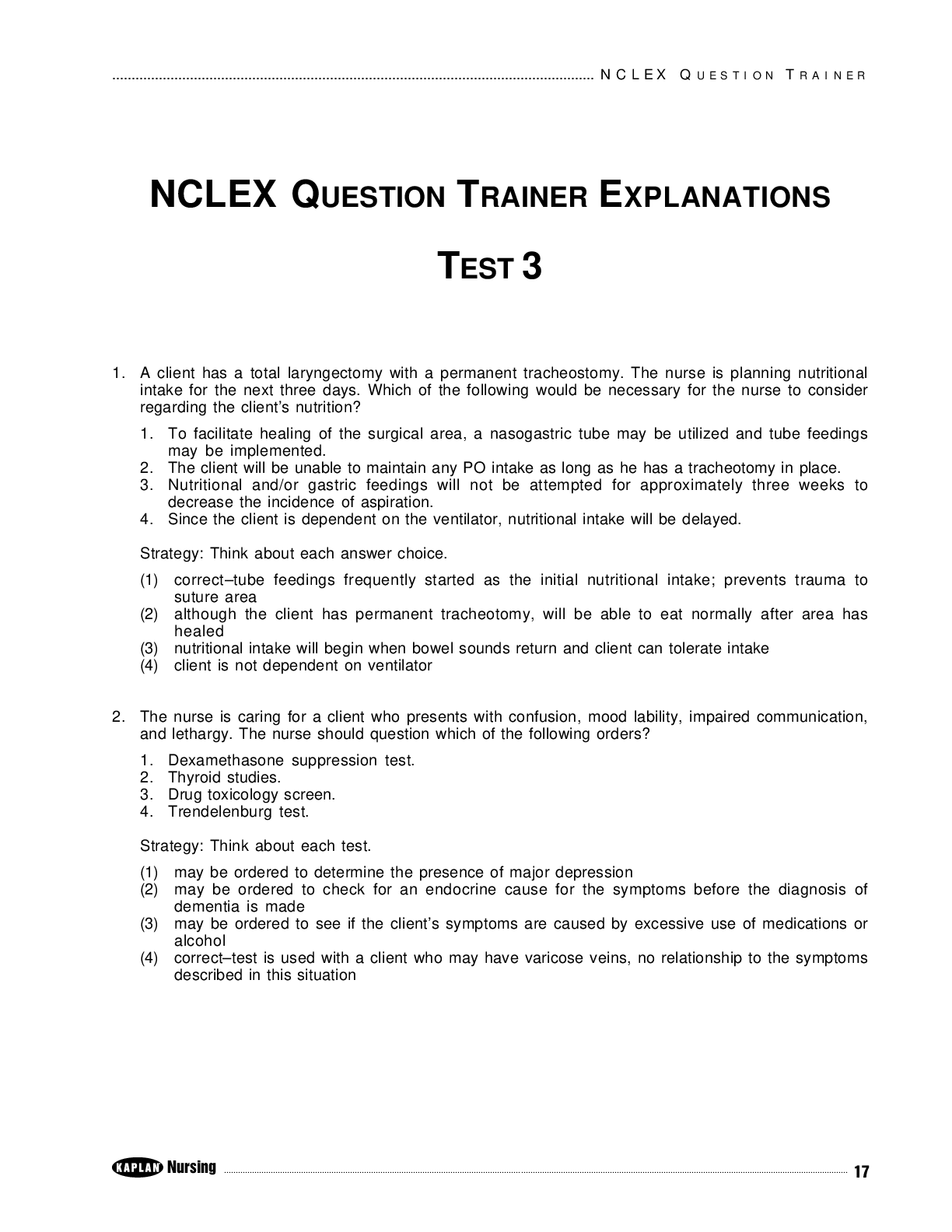
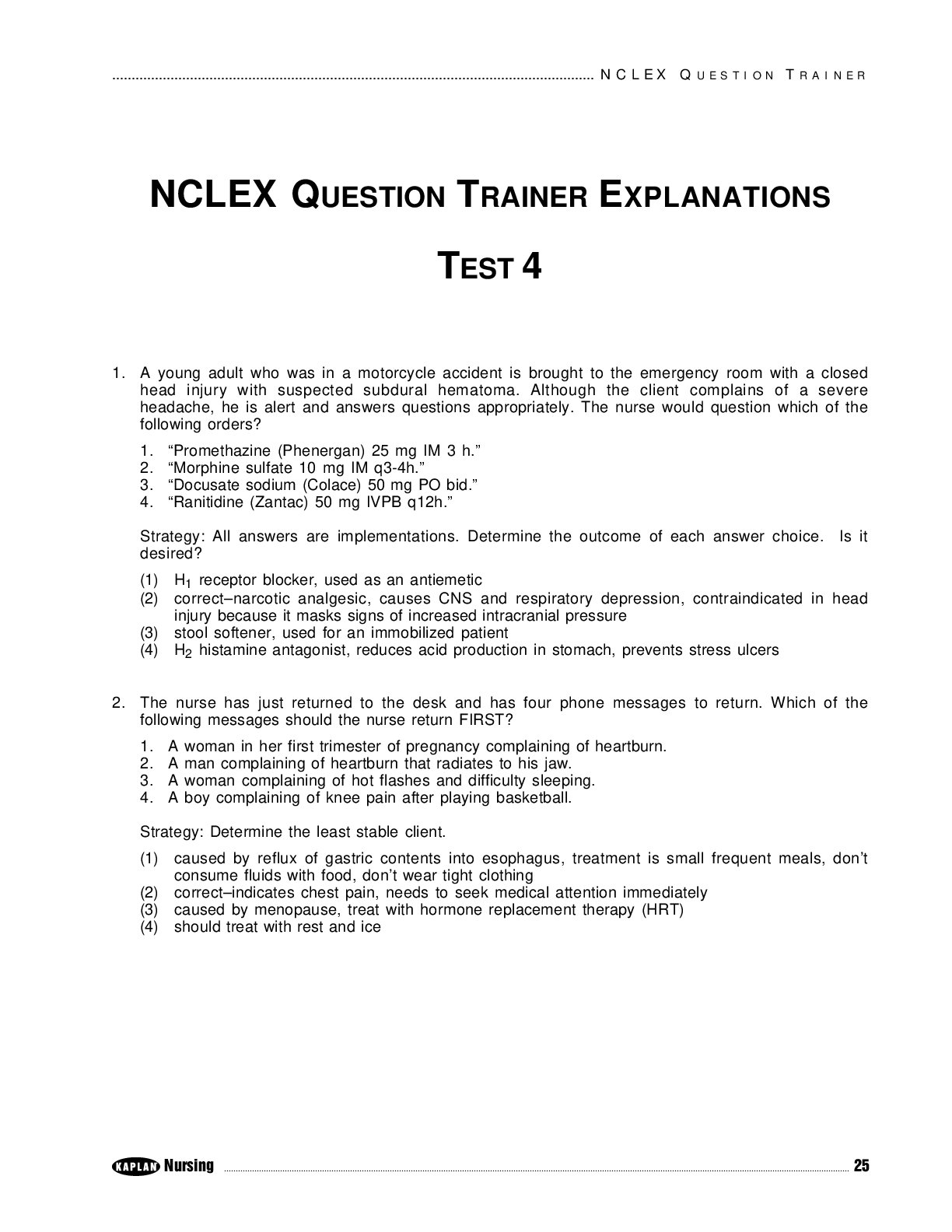
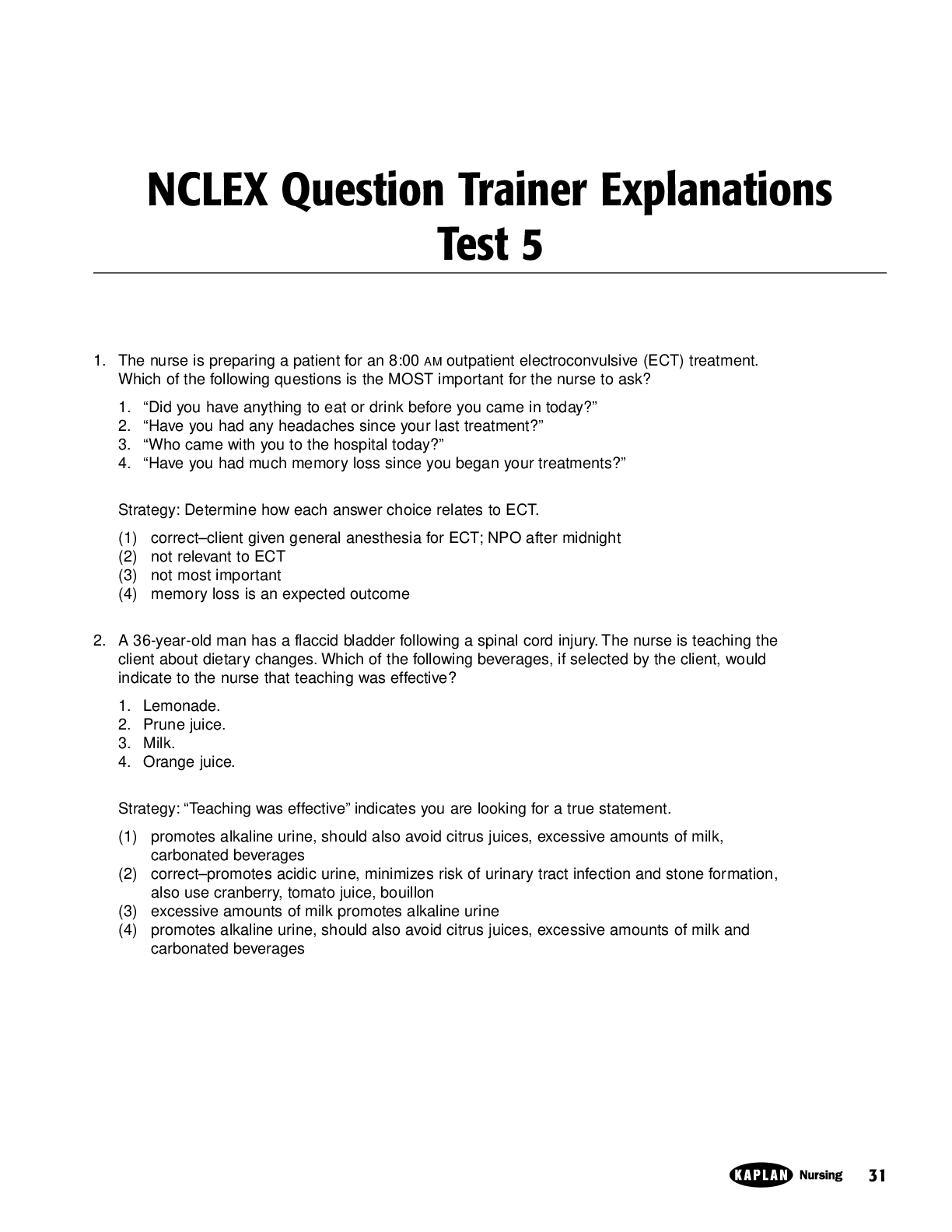
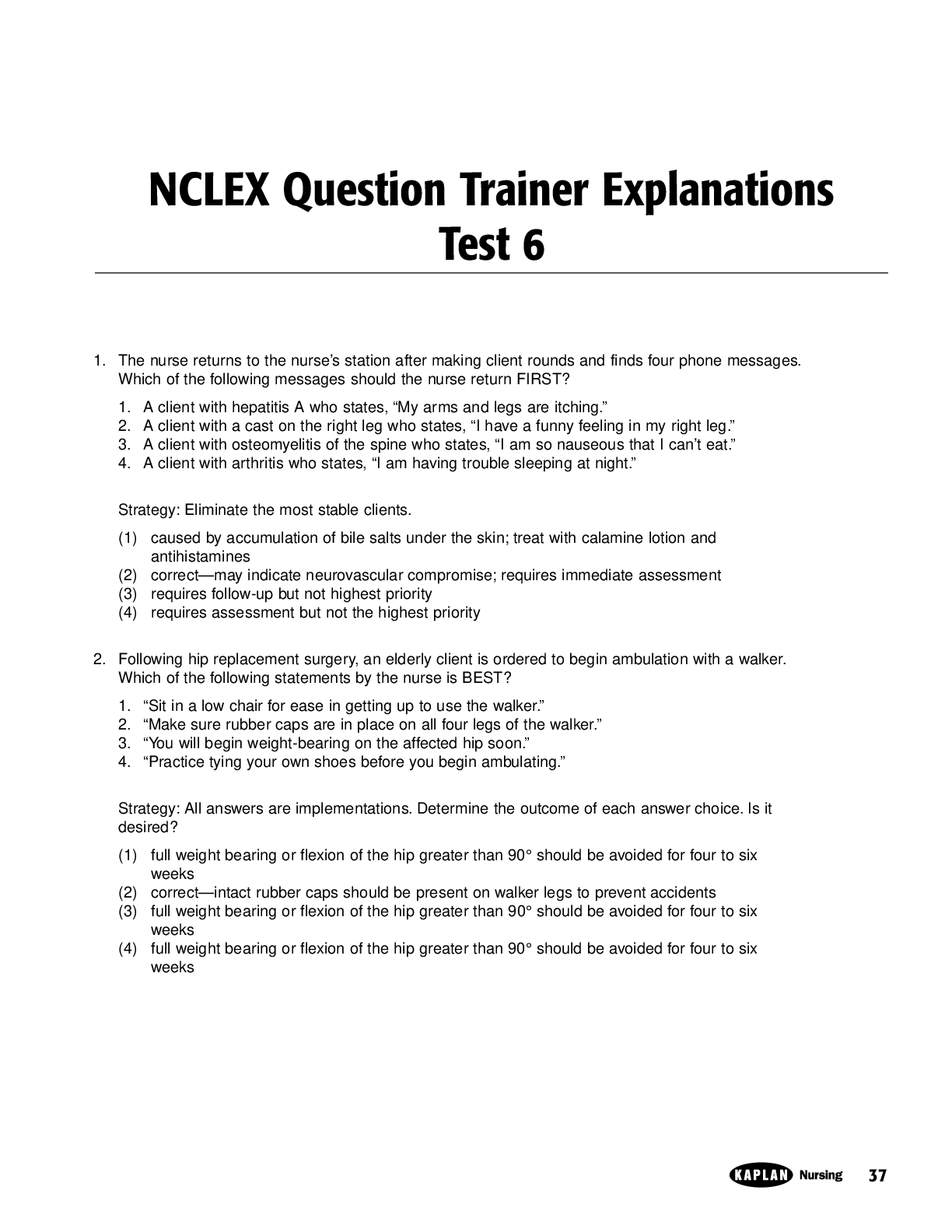
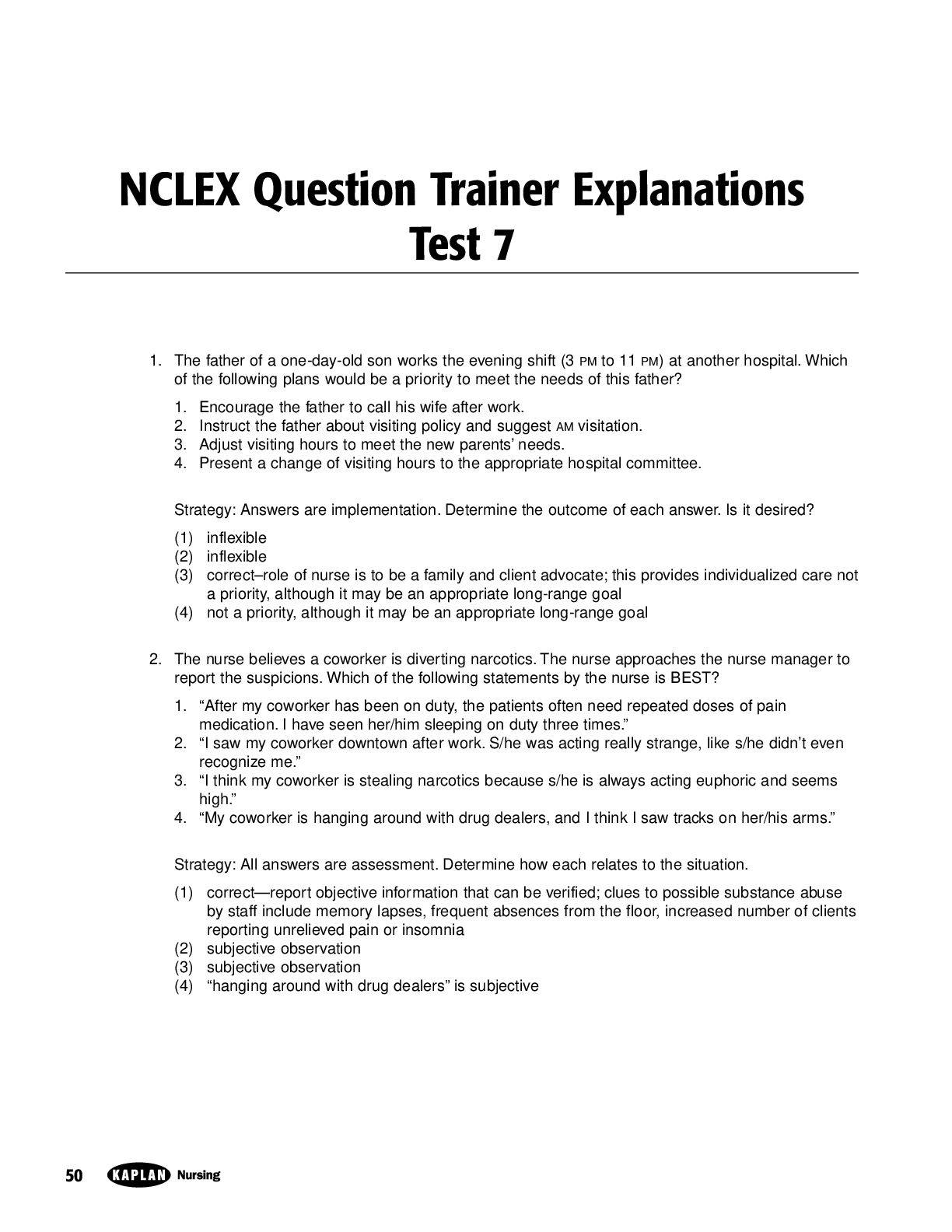
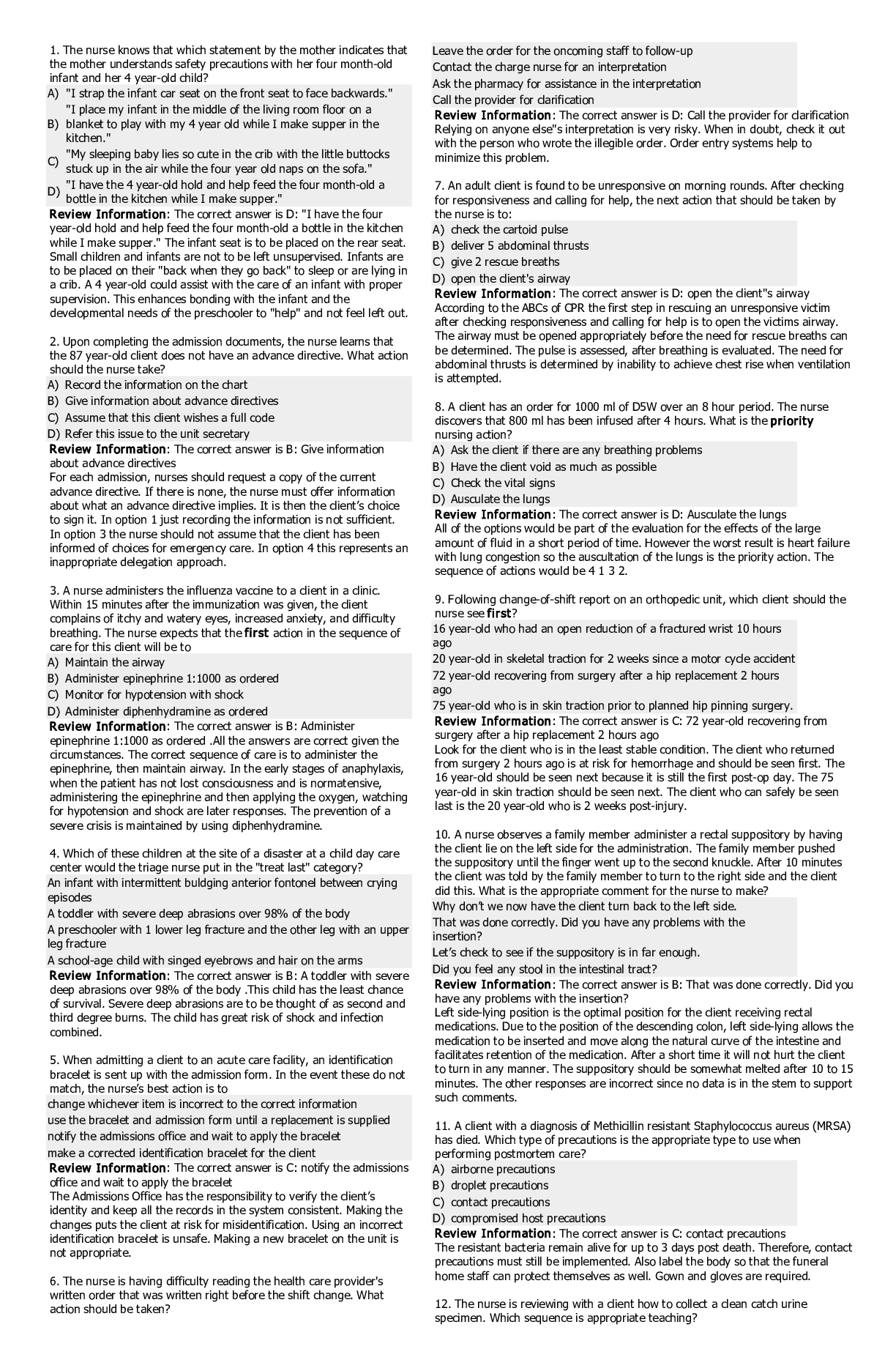
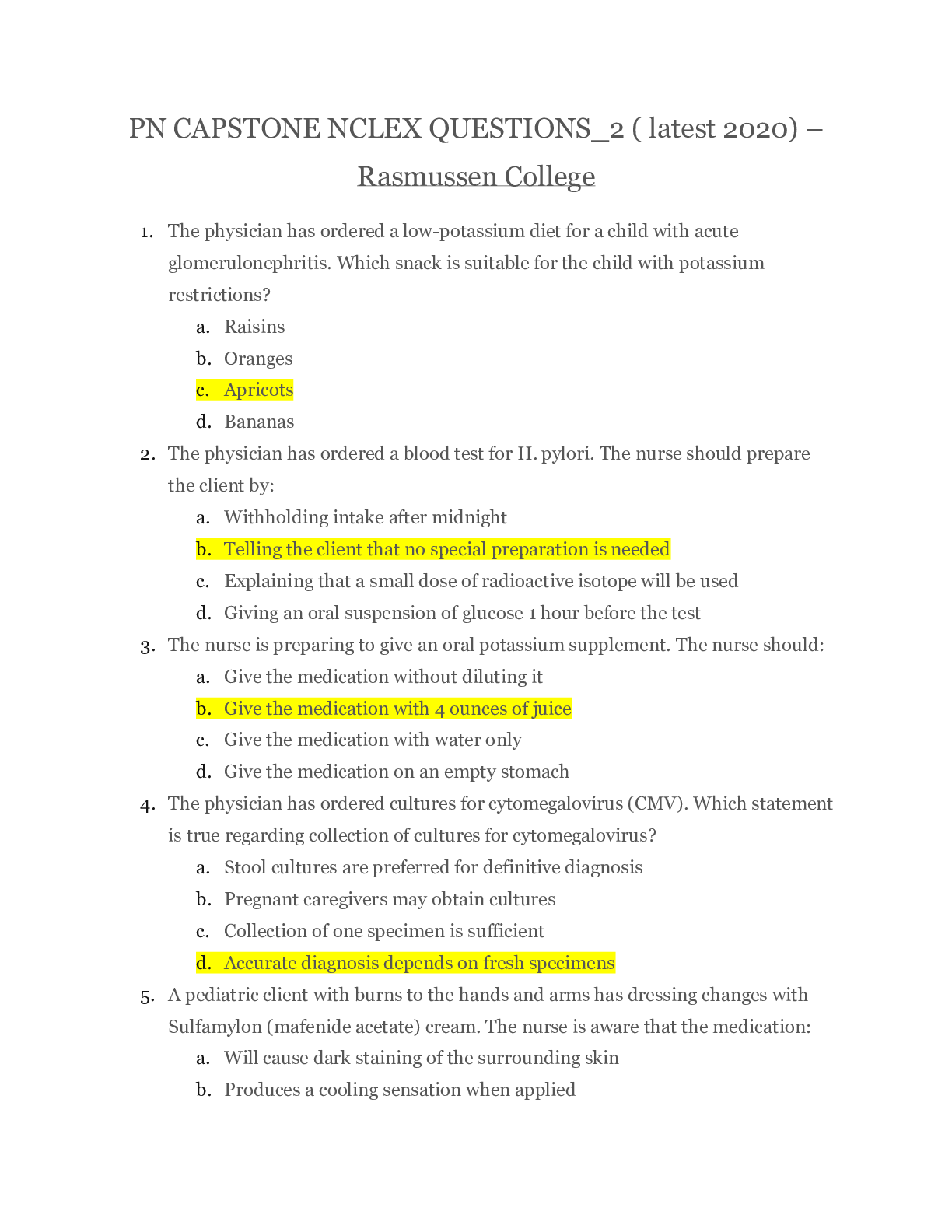




.png)
.png)
.png)
.png)
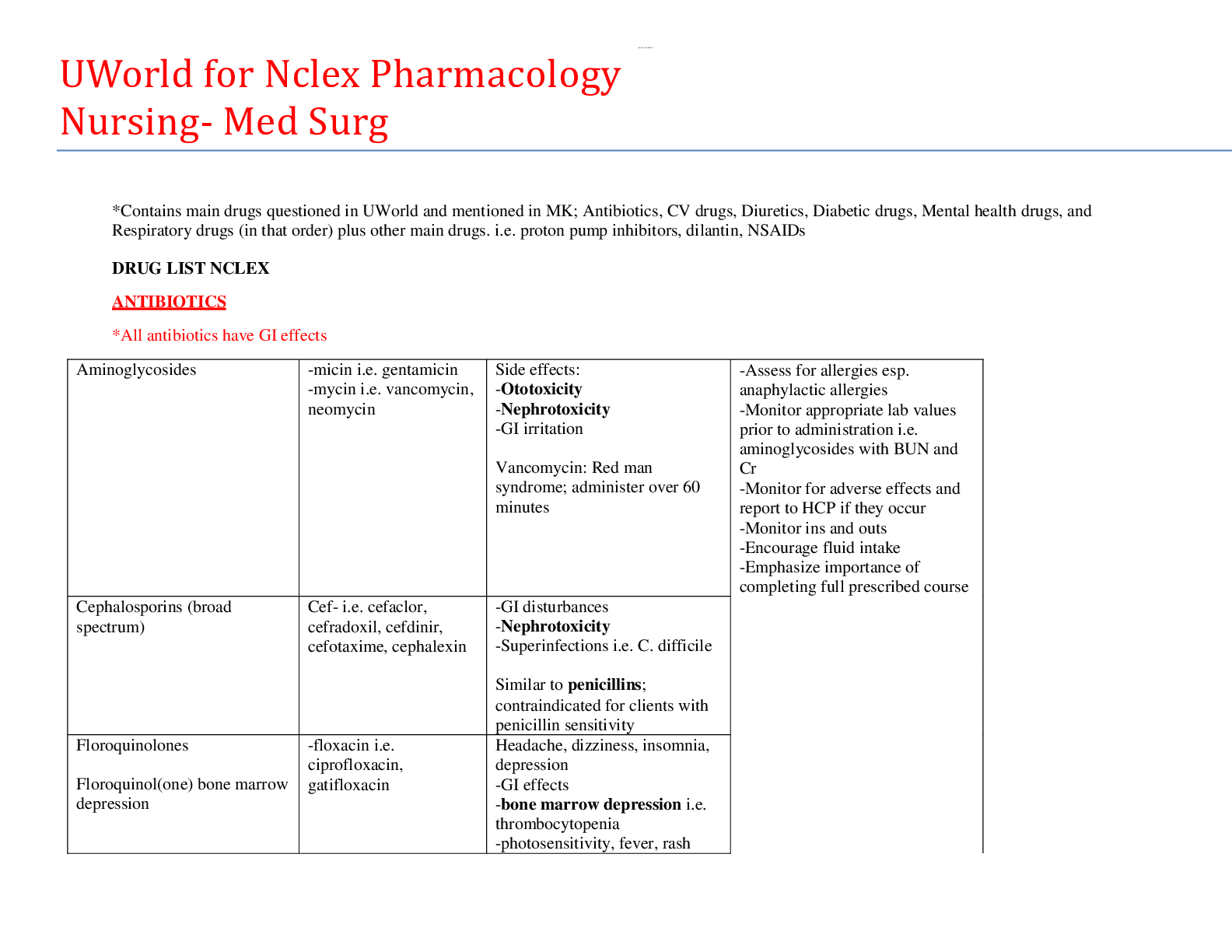

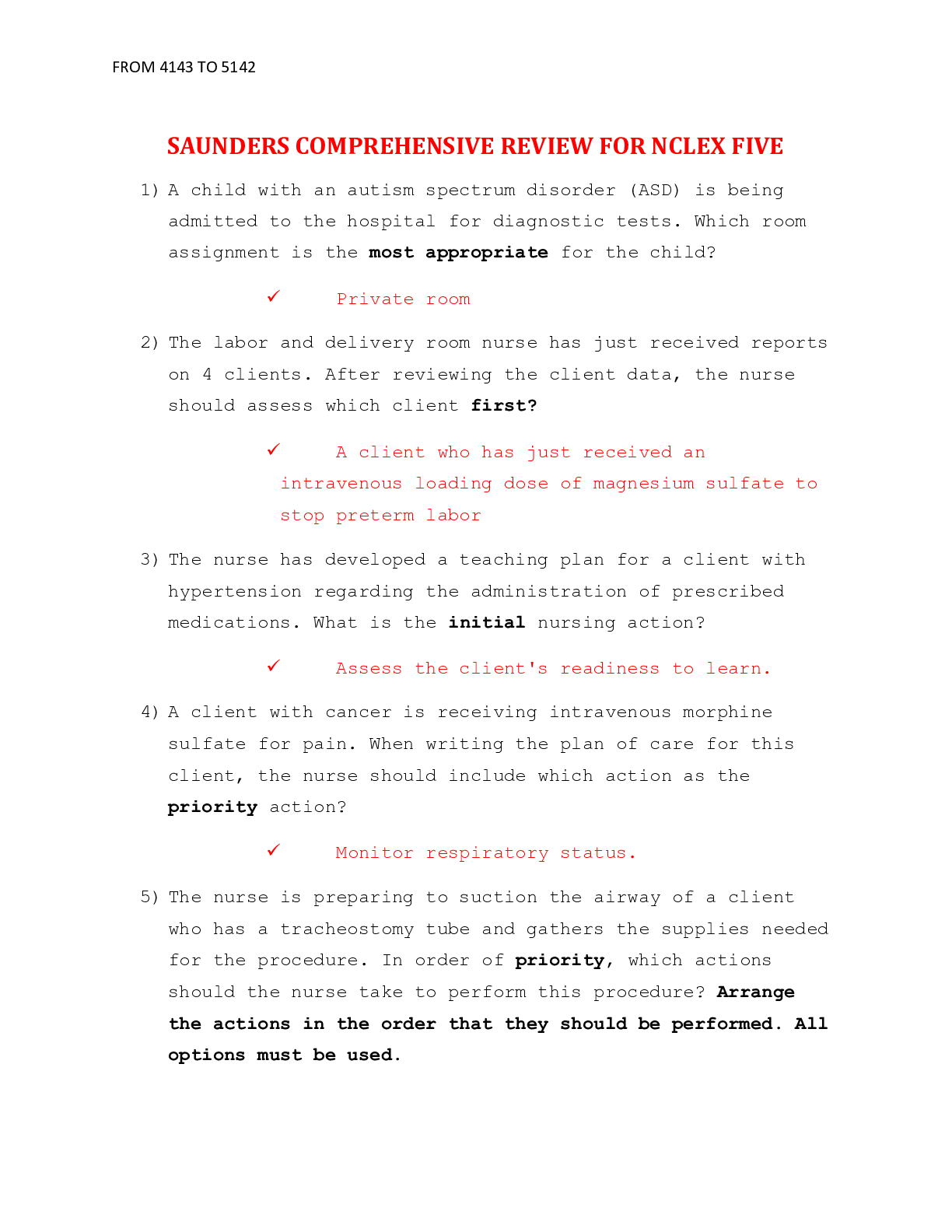
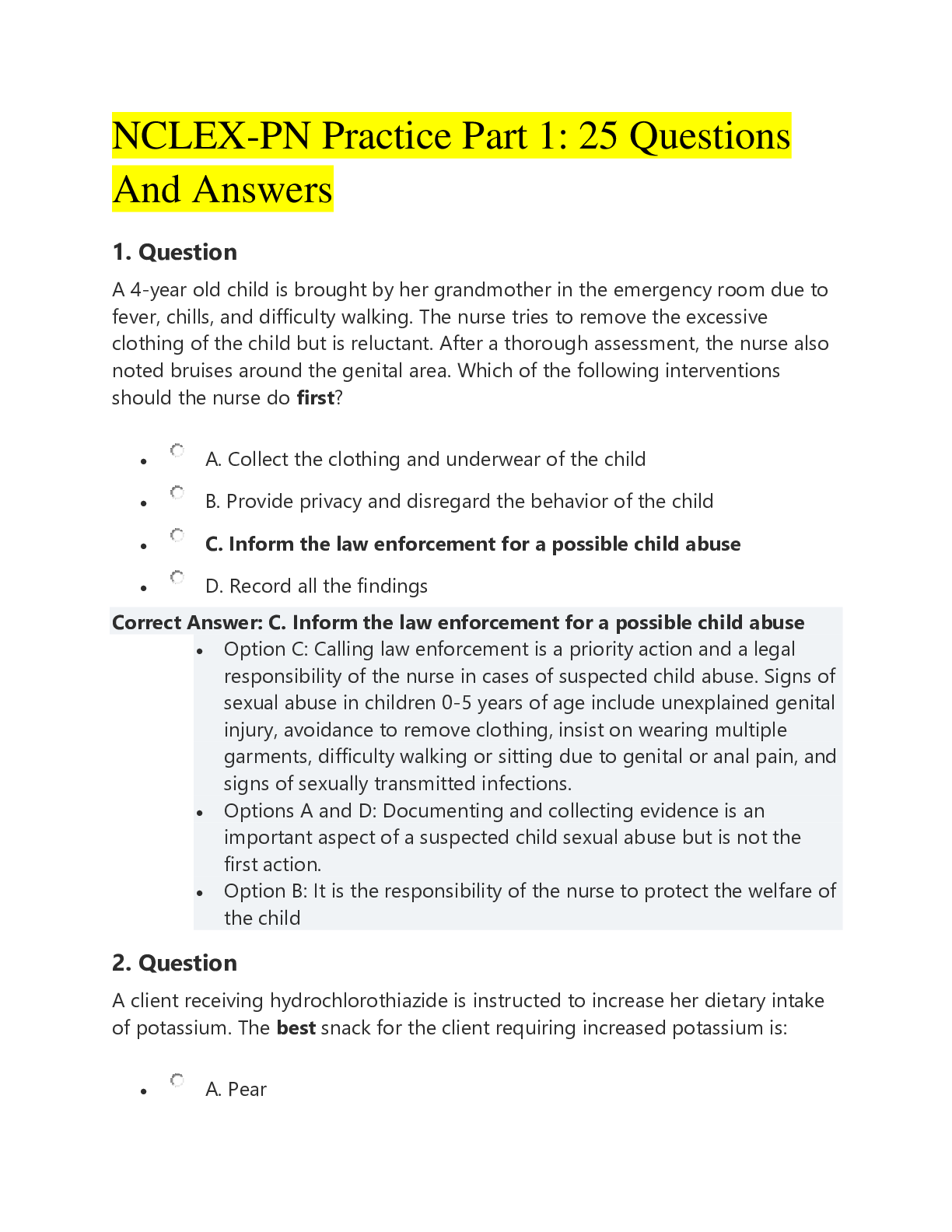
.png)
